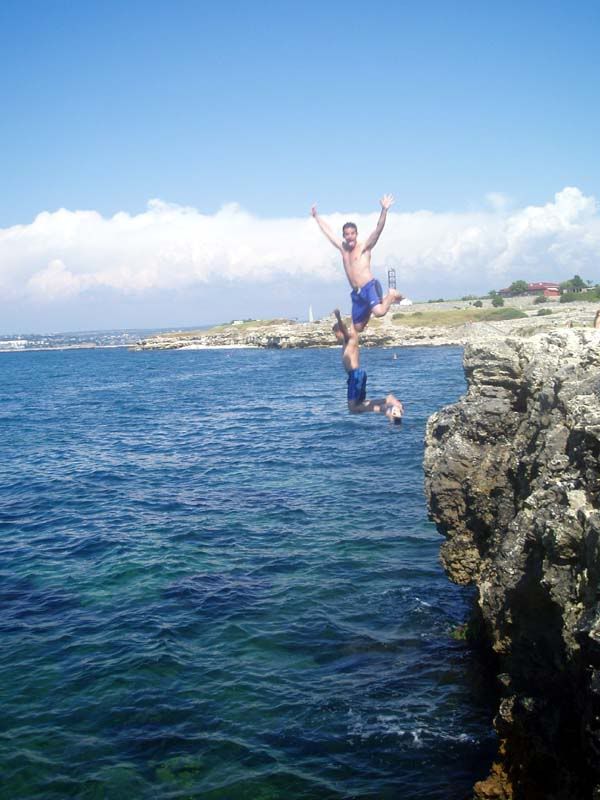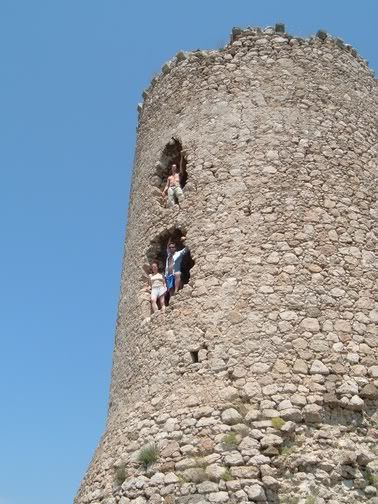Well, the day certainly went from worse to better. Waking up after a ostly sleepless night, sleeping in the kitchen with Sean and Carrie on steadily deflating air mattress. I opted out of that to sleep on the hallway florr, and then squeezed myself between Amy and the arm rest of the fold out couch. I woke up with the right side of my body asleep, woke Amy up and shoved her over, stole the sleeping bag that was entangled with the legs of Lauren (also lseeping on the pull out couch) and finally got a few hours of sleep.
This was after an eening smoking apple-flavored tobacco fro a hookah while sitting on cucshions in a Turkish-themed bar. I ended up talking politics (which I’m not supposed to do) with a Crimean couple in the bar. The girl spoke English and no Ukrainian, the guy spoke Ukrainian, but no English. We still got on, though. They think Yuchenko shouldn’t have won, believed that the Orange Revolution was largely western bought. This is nothing new in Crimea, which is actually an autonomous republic within Ukraine and in a narrow referendum nearly allied itself with Russia. Its populace is still largely Eastern-leaning at heart.
We went in search of a club, but found them wanting. Paty promises that the best club in all of Crimea awaits us on Friday, to a hefty 20 hrivn cover charge.
In any case, after a morning of teaching that was largely a blur (although apparently it went wel), we took the students up to Hirsonse. I made a mistake in my last blog (or, rather, I was mislead). Balaclava was not a 2,500 year old fortress built by the Greeks (I had wondered, considering it didn’t look remotely of what I thought of Greek architecture being; but I figured I was ignorant). No, that was a 14th century castle. Hirsonse was actually the Greek settlement, and was actually 2,500 years old, not 3,000.
It was, in short, amazing.
But we’ll get to that.
I have yet to actually get some description going on Sevestopal, which I think it deserves a bit of. In many ways, Sevestopal is a average Ukrainian city: the exposed pipes, crumbling asphalt, rusting balconies and plaster on the exteriors cracking and looking like the buildings have varicose veins.
But it feels different. There’s the tang of salt from the black sea in the air, the people are friendlier (as confirmed and repeatedly mentioned by all the volunteers in for the camp) and there’s an intriguing hint of history built into every nook and cranny. Stairs that are out of place, too old and the wrong style, lead up to Soviet apartment buildings. Columns and carved promenades, their edificases worn down to just a bare hint of themselves, peek at the end of alleys. Behind Patty’s apartment, past a basketball court surrounded in rusting chainlink fencing, the backboards splintered and the hoops gone, is an old stone arch, imploaded steps leading down to it, tiny black kittens playing at the grass at its base. Who built it? How old is it? Who knows? It just sits unrecognized in the courtyard between a cluster of aging apartments. I like Sevestopal. I really do. But I was reminded again that it is Ukraine when, twenty minutes into the first writing of this blog, the power to the building the internet café was in went out, and I lost everything I had just written.
Perhaps the greatest evidence of this great history is Hirsonce, the Greek sea-side settlement. In the pictures I’ve seen, it’s a couple of columns, and a famous arch that’s on the back of the one hrivna bill. Except I was shocked to find its more than that, so much more than that, the foundations of a whole city, stone squares marking houses, the spaces in between hem streets, spreading for acres and acres along the sea shore. That’s only twenty percent of the spectacle, though, because the majority of the foundations are underwater, in the shallow basin folled with the waters of the Black Sea after an Earthquake. After the students left, the tour completed, we spread out towels on the rock beach and swam out into the water, my swimming goggles (picked up in Zhytomyr in order to add swimming to my fitness regime) making the rounds to see the ruins we were standing on as the surge of the water buffeted us back and forth. The ruins were almost unregonizble, just smoothed stone covered in lichen and seaweed. Still, we were standing on underwater Greek ruins. Back on dry land, Carrie and some others tossed a Frisbee back and forth among Corinthian columns while Patty and I baked in the sun, lobbing seminar ideas back and forth for her upcoming training. They were playing Frisbee in Greek ruins. Sean and I hiked up to a small cliff overlooking the water. On the way were dozens of pottery shards amongst the rocks, so common that they were left. I picked up a few. The cliff was about ten to twelve feet high, but the water below was less than five. Still, I had never gone cliff diving before. We both jumped, my hands spread and my legs tucked to not slam into the sea floor. Survival assured, we climbed back up the rocks of the cliff and did it again.
 Sean above, me slighly below, cliff diving into the Black Sea
Sean above, me slighly below, cliff diving into the Black Sea Carrie took pictures of us doing it, one of the hundreds now rapidly filling up my 512MB card in my camera, which is nearly maxed out. I have so many awesome picures: vistas and castles and rstudents and ruins and friends and dolphins and moments and I feel slightly frustrated at my inability to share them. To even get one online is currently a process, a problem when traveling in a non-first world country and trying to share those travels with others in the world.
Still, they will be shared, although it will probably be weeks until I am in a position to do so. In the meantime, life is absolutely fantastic and every frustration I ever felt over the long winter has been evaporated by the summer sea-side sun.

Me, Carrie and Sean at the ruins of teh castle at Balaclava. There are no stairs to the upper window. I had to climb to it! If this were America, we probably wouldn't even be allowed to touch it!